#federal works administration
Text

FWA Art
1940 Tonopah Nevada
12 notes
·
View notes
Text


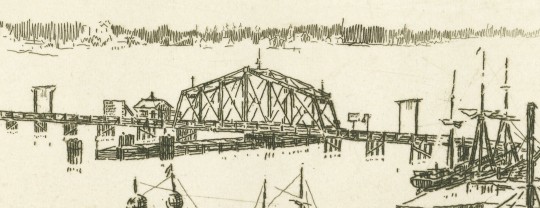


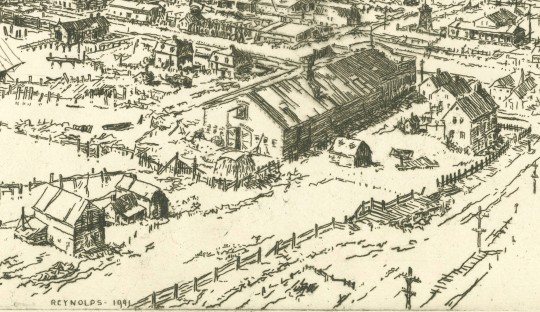

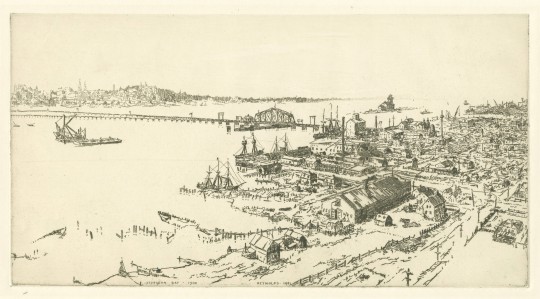
Old Sturgeon Bay, Wisconsin, 1900
Wisconsin architect and printmaker Charles Clark Reynolds (1893-1969) produced this etching of the Door County port city of Sturgeon Bay for the Federal Art Project of the WPA in 1941. Reynolds, who was born in Sturgeon Bay, ran a successful architectural firm with offices in Manitowoc and Green Bay, Wisconsin from 1920-1934. Andrew Stevens, curator emeritus of prints, drawings and photographs at the Chazen Museum of Art at the University of Wisconsin-Madison, made these observations about another copy of the print at the Wisconsin Historical Society in his 1998 exhibition catalog, 150 Years of Wisconsin Printmaking:
The print's title and the notation on the plate that identifies the image as being "Sturgeon Bay 1900" suggest a nostalgic purpose for the work. Instead of presenting the city as it was when the print was made in 1941, he looked back forty years, perhaps by reference to photography, to present if at the turn of the century [as Reynolds himself would have known it as a boy]. As if to reference further the retrospective stance of the work, there is a pencil notation in the print's margin that identifies it as having been printed on antique paper. This retrospective aspect of the work . . . may also reflect some of the historical goals of other projects of the WPA.
Our copy of the print is part of a portfolio of prints from the Wisconsin WPA, and this image is from a digitized version of that print from our digital collection Wisconsin Arts Projects of the WPA, which was made possible with generous financial support from The Chipstone Foundation.
View other posts on prints by Charles Reynolds.
View more posts from our Wisconsin Arts Projects digital collection.
#Old Sturgeon Bay 1900#Sturgeon Bay#Wisconsin#etchings#Charles Reynolds#Charles Clark Reynolds#Federal Art Project#Works Progress Administration#WPA#Wisconsin Arts Projects of the WPA#Andrew Stevens#digital collections#intaglio prints#Wisconsin artists
65 notes
·
View notes
Text
On Thursday, the Social Security Administration announced its largest cost of living adjustment for beneficiaries in four decades, an inflation-driven raise of 8.7% that will take effect in January 2023. That increase matches the average annual COLA from 1975 through 1982, an era of recessions and high inflation. Annual Social Security raises declined after that year. From 1996 through 2021, they averaged 2.3%, and were zero in some years. The 2021 raise was substantially higher: 5.9%.
The new increase in benefits will be pricey. On the other hand, the cost to taxpayers of the entire Social Security program pales in comparison with the cost of federal subsidies for rich Americans enrolled in private or supplemental retirement plans, such as individual retirement accounts (IRAs). According to Federal Reserve data from 2019, only 31% of households from the poorest half of the wealth spectrum contributed to such a plan, while 91% of households in the top wealth decile did.
This suggests that low-wealth retirees rely heavily or exclusively on Social Security, but all US workers get to collect benefits starting at age 62. As of last month, nearly 66 million Americans, rich and poor alike, were getting monthly checks. Most are retirees, but there are also spouses, disabled workers, survivors of deceased workers, and dependent children. The largest and best-compensated group, the retired workers, averaged $1,674 a month, or about $20,000 per year.
The SSA now pays out about $1.2 trillion a year in benefits all told, but those outlays are largely funded by payroll taxes paid by workers who will later reap the benefits. In 2021, the price tag of the entire program—benefits plus administrative costs—totaled $1.14 trillion, of which $1.09 trillion was covered by payroll taxes, income taxes on benefits, and interest. In other words, the federal Social Security subsidy was only about $50 billion.
Compare that with subsidies for private plans and IRAs, which cost the government nearly eight times as much—about $380 billion a year, according to the Joint Committee on Taxation. And unlike Social Security subsidies, these subsidies skew heavily toward the highest earners.
There’s a reason I noted the year 1996 above. Before then, as I point out in this earlier exposé about America’s retirement system, private retirement accounts were strictly regulated and not heavily subsidized. Starting that year, federal lawmakers—led by then Reps. Rob Portman (R-Ohio) and Ben Cardin (D-Md.), began introducing bipartisan retirement “reform” packages that pumped more and more federal dollars into bolstering private retirement savings, mainly to the benefit of high-income workers and Wall Street.
University of Virginia law professor Michael Doran, who dug deep into the subject for a January 2022 paper titled, “The Great American Retirement Fraud,” suggested that lawmakers, rather than helping rich Americans shuffle even more of their money into tax-deferred or tax-exempt retirement funds, could instead pass laws to benefit Americans who actually need help in retirement. That might include simply beefing up Social Security, he wrote.
Instead, yet another bill that benefits wealthy savers sailed through Congress. And Republican Rick Scott released a set of aspirations for his own party—an 11-point “Plan for America,” of which one provision would let all federal laws “sunset” every five years—including laws governing Social Security and Medicare.
#us politics#news#mother jones#social security administration#social security cuts#social security#social security works#individual retirement accounts#federal reserve#cost of living adjustment#Joint Committee on Taxation#Rep. Rob Portman#rep. Ben Cardin#Michael Doran#The Great American Retirement Fraud#sen. rick scott#Plan for America#2022
47 notes
·
View notes
Text

In 1937, the WPA's Federal Art Project commissioned Japanese-American artist Eitaro Ishigaki to paint two murals for the Harlem Courthouse. It was part of an ambitious project for murals all over the city; in the end, there were about 400 designs, although many were never painted.
Ishigaki's murals, American Independence (above) and Emancipation, received a hostile reception in the community. In 1938 the City Council branded them "offensive" and removed them. (That may be some Council members taking notes, above, March 31, 1938.) It's unclear whether they were preserved.
Other Harlem murals included work by African-American artists.

Top photo: Associated Press via Shutterstock
Bottom photo: Smithsonian Institution
#vintage New York#vintage Harlem#1930s#Eitaro Ishigaki#Harlem Courthouse#Federal Art Project#public art#Work Progress Administration#murals#art#art history#Harlem murals#Federal Art Project murals#art controversies#March 31#31 March#Mar. 31
47 notes
·
View notes
Text
“ Invece di seguire il programma di austerità del suo predecessore Hoover, il presidente del New Deal, come ha notato Barbara Spinelli su «la Repubblica», «aumentò ancor più le spese federali. Investì enormemente sulla cultura, la scuola, la lotta alla povertà». Purtroppo, aggiunge la Spinelli, «non c’è leader in Europa che possegga, oggi, quella volontà di guardare nelle pieghe del proprio continente e correggersi. Non sapere che la storia è tragica, oggi, è privare di catarsi e l’Italia, e l’Europa».
Già: addirittura una «catarsi». Ma è proprio quello che ci vorrebbe. Roosevelt, infatti, non mise solo i disoccupati a scavare buche e a riempirle, come tanto spesso si dice. Tre dei più importanti progetti della Works Progress Administration, i più singolari, innovativi e duraturi, furono quelli compresi nel cosiddetto Progetto Federale numero 1, altrimenti noto come Federal One, che sponsorizzò per la prima volta piani di lavoro per insegnanti, scrittori, artisti, musicisti e attori disoccupati. Il Federal Writers’ Project, il Federal Theatre Project e il Federal Art Project misero al lavoro per qualche anno più di ventimila knowledge workers (come li chiameremmo oggi), tra i quali c’erano Richard Wright, Ralph Ellison, Nelson Algren, Frank Yerby, Saul Bellow, John A. Lomax, Arthur Miller, Orson Welles, Sinclair Lewis, Clifford Odets, Lillian Hellman, Lee Strasberg (il fondatore del mitico Actors Studio) ed Elia Kazan.
Non si trattò di elemosina: checché. Oltre a produrre opere d’arte (migliaia di manifesti, disegni, murales, sculture, pitture, incisioni...), gli artisti plastici e figurativi vennero impiegati nella formazione artistica e nella catalogazione dei beni culturali, e crearono e resero vivi anche un centinaio di community art centres e di gallerie in luoghi e regioni in cui l’arte era completamente sconosciuta. In tre anni, nella sola New York, più di dodici milioni (12.000.000!) di persone assistettero agli spettacoli teatrali incentivati dal Federal Theatre Project. Quanto al Writers’ Project, che costò ventisette milioni di dollari in quattro anni, produsse centinaia di libri e opuscoli, registrò storie di vita di migliaia di persone che non avevano voce e le classificò in raccolte etnografiche regionali, ma soprattutto, con le American Guide Series, contribuì a ridare forma all’identità nazionale degli Stati Uniti, che la Grande Depressione aveva profondamente minato, fondandola su ideali più inclusivi, democratici ed egualitari. E scusate se è poco.
Tuttavia anche lì, e anche allora, non mancavano i sostenitori dell’idea che la cultura è un lusso e, soprattutto, un lusso di sinistra. Dal maggio del 1938, sotto la guida di due «illuminati statisti» come Martin Dies e J. Parnell Thomas, la Commissione della Camera contro le attività antiamericane non smise di accusare i tre progetti di essere al soldo di Mosca e non si arrese fino a quando non furono fermati. Poi, venne la guerra e molti sogni si infransero. Ma intanto, con quel solido lavoro culturale alle spalle, le fondamenta di una nuova consapevolezza di sé e di una nuova idea di futuro erano comunque gettate. E da lì, dall’idea di fondo della necessità dell’intervento statale per vivificare la cultura e modificare così la specializzazione produttiva di un Paese, partirà, già durante la guerra, un altro liberale illuminato, Vannevar Bush, consigliere di Roosevelt, per elaborare il famoso rapporto Science: the Endless Frontier, che rappresenta un po’ il manifesto della politica culturale e scientifica – e a ben vedere anche economica – che avrebbero seguito gli Stati Uniti nei successivi decenni fino a Barack Obama. “
Bruno Arpaia e Pietro Greco, La cultura si mangia, Guanda (collana Le Fenici Rosse), 2013¹ [Libro elettronico]
#Bruno Arpaia#Pietro Greco#La cultura si mangia#saggistica#intellettuali italiani#economia#Giulio Tremonti#la Repubblica#Franklin Delano Roosevelt#New Deal#Barbara Spinelli#FDR#knowledge workers#Italia#Europa#disoccupazione#XX sec#Works Progress Administration#Storia del '900#Federal One#Federal Writers’ Project#Federal Theatre Project#America#Commissione contro le attività antiamericane#Saul Bellow#Federal Art Project#Arthur Miller#Orson Welles#Elia Kazan#Sinclair Lewis
21 notes
·
View notes
Text
Artifact Road Trip - New Hampshire
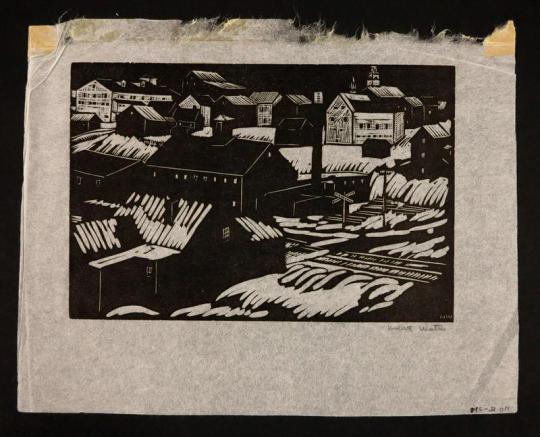
This linoleum cut print Portrait of the Town - Winter Night by Herbert Ogden Waters was created for the New Hampshire Art Project, Federal Art Project, Works Progress Administration.
Find out more about this Artifact Road Trip print on our Digital Artifact Collection: https://fdr.artifacts.archives.gov/objects/30349
Follow along each week as we feature a different artifact in our Museum Collection from each of the United States.

#New Hampshire#artifact road trip#new deal art#federal art project#Works Progress Administration#wpa#franklin d. roosevelt#fdr
12 notes
·
View notes
Text
For May Day: WPA Vaudeville
For May Day: WPA Vaudeville
Well, it’s May the first, May Day, International Workers Day, so here’s a post for all you goddamn rotten, stinkin’ commies.
Today we acknowledge the vaudeville shows that were produced under the supervision of the Variety Unit of the Federal Theatre Project (1935-1939), which was a branch of the Works Progress Administration (WPA), which was a program of FDR’s New Deal. H’m…five separate levels…

View On WordPress
#Federal Theatre Project#Great Depression#New Deal#Variety Unit#vaudeville#Works Progress Administration#WPA
2 notes
·
View notes
Text

Moses Soyer’s oil painting, Young Girl, is one of the works on view in A New Deal: Artists of the WPA from the CMA Collection at Canton Museum of Art. The exhibition is a reminder of one of the best social programs ever created by the US government and the positive impact it had on the country during one of its hardest periods.
From the museum about the exhibition-
Against the backdrop of severe economic strife caused by the Stock Market Crash of 1929, President Franklin Roosevelt created the Works Progress Administration (WPA), which put roughly 8.5 million Americans, including more than 173,000 men and women in Ohio, to work building schools, hospitals, roads and more. Within the WPA was The Federal Art Project (FAP) which provided employment for artists to create art for municipal buildings and public spaces. The FAP had a non-discrimination clause that meant it attracted and hired artists of color and women, who previously received little attention in the art world. The only guidance the government offered about subject matter was to depict the “American scene” and stipulated no nudity or political issues. The goal was for artists to help the United States develop its own distinct American style of art, especially as artists in other parts of the world were forbidden freedom of expression and ordered to create artworks that projected the beliefs of their governments.
Though the WPA artists in the United States shared the common goal of capturing life in all its variety and promoting national pride, they each had different approaches, and many modified their typical subject matter to fit whatever project they were assigned. The arts before and after the New Deal relied on private patronage and the philanthropy of wealthy and elite institutions: galleries, museums, dealers. But during the WPA, art wasn’t a luxury good, it was seen as an essential part of our democracy. Artists were seen as professional workers who were making important and significant contributions to American life. The artworks made under the WPA became the collection of the American people and were put in public collections – hospitals, schools, post offices, housing projects, etc. – ensuring they were part of communities. The arts were seen as an important part of a democratic society and the American way of life, with a richness of experience and accessibility to culture.
While artists were offered opportunities through the WPA, they were far from immune to the distress caused by the Depression, and many still struggled to make a living. Will Barnet detailed a bleak scene he came across, saying:
“It was like a war going on. There were bread lines and men lined around three, four, five, six blocks waiting to get a bowl of soup. It was an extraordinary situation. And one felt this terrible dark cloud over the whole city.”
Moses Soyer also described the hardships artists experienced, saying,
“Depression–who can describe the hopelessness that its victims knew? Perhaps no one better than the artist taking his work to show the galleries. They were at a standstill. The misery of the artist was acute.”
The FAP supported the creation of thousands of works of art, including more than 2,500 murals that can still be seen in public buildings around the country. The FAP also supported art education and outreach efforts, including traveling exhibitions and art education programs for children. The WPA and FAP had a significant impact on the American art scene, and many of the artists who participated in the program went on to become important figures in the art world.
A New Deal: Artists of the WPA from the CMA Collection highlights the lives of artists from our Permanent Collection who worked for the WPA, and in doing so, fostered resilience for a struggling nation. You will learn about the projects they worked on, the subjects they were interested in, and how their own lives were affected by the Depression. Each of these artists helped to foster the nation’s spirit and prove that even in the darkest of times, art serves as a uniting force to collectively lead people into a brighter future.
And about Moses Soyer and his painting from the museum-
The Depression set the mood for most of Soyer’s art expression, and his portraits of people seem to be preoccupied with a sad secret. His portraits were often of solitary fi gures, using professional models or his friends, capturing in these paintings the spirit of his sitters, their dreams or disillusionment. He is best known for his introspective fi gure paintings of weary, melancholy women in muted colors, matching the mood of his sitters with the pigment in his paint. He was inspired by artist Edgar Degas, who used color expressively.
On the museum’s website you can find both the artwork on display for the exhibition and also a gallery of the museum’s entire collection organized into several categories.
#Moses Soyer#Art#Canton Museum of Art#Art History#Art Shows#Canton Art Shows#Works Progress Administration#Drawing#Federal Art Project#President Franklin D. Roosevelt#Franklin D. Roosevelt#Government Programs#Great Depression#History#Ohio Art Shows#Painting#The New Deal#WPA
0 notes
Text
Grand Convocation Chamber

STAR WARS EPISODE I: The Phantom Menace 01:26:51
#Star Wars#Episode I#The Phantom Menace#Coruscant#Galactic City#Galactic Senate Building#Grand Convocation Chamber#Supreme Chancellor Finis Valorum#Vice Chair#Mas Amedda#Chancellor's Podium#Sei Taria#Administrative Aide#Senate hovercam droid#Galactic Republic#Senate Rotunda#Trade Federation#Chancellor's working office#Chancellery Secretariat#Great Galactic Seal
0 notes
Text
How to Qualify For a Kentucky FHA Mortgage Loan
How to Qualify For a Kentucky FHA Mortgage Loan
The requirements for Kentucky FHA loans are set by HUD.
Borrowers must have a steady employment history of the last two years within the same industry or line of work. Recent college graduates can use their transcripts to supplant the 2-year work history rule as long as it makes sense.
Self-Employed will need a 2-year history of tax returns…

View On WordPress
#100 down kentucky fha loan#2023 fha mortgage guidelines kentucky#500 credit score FHA loan#appraisal issues on FHA#appraisals fha loans#back to work program FHA KY#bad credit fha loans Kentucky#bankruptcy fha#bonus income fha loan#canceling mortgage insurance FHA loan#chapter 13 fha and usda loan approval#cornovirus fha loans ky#Federal Housing Administration#FHA insured loan#Kentucky#ky first time home buyer#Louisville Kentucky#Mortgage loan#zero down loan kentucky
0 notes
Text
Justice 40
Joe Biden is boring and often bad at tooting his own horn, but by god, he is good at process.
Justice 40 is simple but powerful application of that. its a shift in how the executive branch works. 40% of money from a bunch of existing programs should go to census tracts that are overburdened with pollution, at higher risk for climate change, and have been historically underserved.
The shorthand here is basically "communities that don't have enough internal resources to deal with long term problems". So yes, communities that had been redlined for decades, ones that have Superfund sites, ones that have high rates of asthma from air pollution.
and this is by census tract. Not city. census tract. So parts of New York City qualify... but other parts don't. And the city HAS to use the money in the targeted part. it doesn't go into the communal pool. it's for THAT tract specifically.
Also all land federally recognized as belonging to a Native American tribe and all Alaskan Native Villages qualify, specifically.
And again, this is for existing programs that are already running and have existing staff and budgets. They're supposed to prioritize grants and projects for those areas specifically. And that's everything from Department of Agriculture, to FEMA, to Labor, to Environmental Protection.
Does it instantly get rid of all the baked in racism from decades past? No, not even close. But it puts in a countermeasure that has a concrete and measurable goal to aim for rather than a nebulous "suck less." even if the administration changes, many of those changes will stick.
And as things improve, some tracts may come off the list! Some may go on that weren't there before!
You can see a map here. Blue highlighted tracts are "disadvantaged" so qualify for that extra assistance! Check and see if you live in one or part of your town does. Because if you've been hearing constantly "we can't afford to fix X problem..." and you're in that tract.... there's money available. For you. Build that sidewalk, fix those lead pipes, get that brush truck your volunteer fire department has been asking for.
And tell your local officials that! "did you look at Justice 40 for funding". And even if they're doing their best, particularly people in little towns.... being a government official isn't their full time job. They may have missed it. Just asking them about the program may suddenly open a world of possibilities.
9K notes
·
View notes
Text
In the week since the International Court of Justice ruled that the Israeli government is plausibly committing genocide and ordered it to prevent potential further acts of genocide, Israeli forces have only continued committing atrocities against Palestinians.
Buoyed by the staying support of American officials, Israeli forces have killed at least 874 Palestinians and injured at least 1,490 in Gaza since last week’s ICJ ruling, according to Palestinian Health Ministry figures from Saturday, January 27, to Friday, February 2. That’s not to mention other acts of Israeli violence in the occupied West Bank and Jerusalem.The loss of life should not be dismissed as “collateral damage,” contrary to what Prime Minister Benjamin Netanyahu has said.[...]
Backgrounding the atrocities in Gaza is the broader misery the entire population faces. The BBC noted that UNICEF’s biggest concern is the “estimated 19,000 children who are orphaned or have ended up alone with no adult to look after them.” CNN reported that Palestinians are eating grass and drinking polluted water amid famine conditions. The Guardian reported that 50-62 percent of all buildings in Gaza have likely been damaged or destroyed.
Earlier this week, a federal court affirmed the ICJ’s finding that Israel may be carrying out a genocide and warned the Biden administration to reconsider its unconditional support for Israel’s war effort. [...]
The Intercept asked Sen. John Fetterman, D-Pa., to comment on the court rulings that the accusations of genocide by Israel are credible. “I don’t accept that. I reject [the ruling of the International Court of Justice]. I don’t believe that is Israel’s intention: to commit genocide,” said Fetterman, who has emerged as one of Israel’s most staunch Democratic defenders, on Thursday. “I do believe that their goal is to neutralize or dislodge Hamas from that. And I believe that they certainly do not want to take the lives of any innocent Palestinians and I certainly don’t assign higher value to my children versus a Palestinian child. I mean, I wouldn’t want anybody to die throughout all this tragedy, and it’s just an awful situation.”
Within hours of the ICJ issuing its ruling last Friday, Israel alleged that 12 of 30,000 — 0.04 percent — employees of the United Nations Relief and Works Agency for Palestine Refugees in the Near East were involved in Hamas’s attack on October 7. The United States immediately suspended its funding of UNRWA, the largest provider of humanitarian aid in Gaza, spurring a cascade of other nations to follow suit.
Sky News later obtained an Israeli document that actually downgrades the allegation to 0.02 percent of UNRWA staff (six people) being involved in Hamas’s attack. Sky News reported that the documents, which allege further ties between UNRWA and Hamas “make several claims that Sky News has not seen proof of and many of the claims, even if true, do not directly implicate UNRWA.”
The contrast between the U.S. decision to pause funding based on unverified allegations and its unwillingness to reconsider its military funding of Israel, despite serious allegations of genocide, is stark.
Fetterman also said that he supports the suspension of funding to UNRWA. When asked why the standard of suspending funding while investigating serious allegations doesn’t apply to the Israeli government, Fetterman dodged the question.
Fetterman: Well, again, it — well, it’s not. We need a full investigation and find out just how much a part of it was about that and how much, you know, the old question: how much they knew and when they knew that.
The Intercept: So you’re saying that for Israel as well?
Fetterman: Yeah, OK, so good, all right, well good.[...]
Reporter Said Arikat confronted State Department spokesperson Matthew Miller on the tension Wednesday. “I’ll say with respect to the charges of genocide [at the International Court of Justice], we believe that they’re unfounded,” Miller said. “We continue to support Israel’s right to take action to ensure that the terrorist attacks of October 7th cannot be repeated, but we want them to do so in a way that complies with — fully with international humanitarian law.”
Miller was then asked about Israel receiving aid even as Israeli government officials call for the ethnic cleansing of Palestinians and maintain good standing in government.
“When the secretary traveled to Israel on his most recent visit,” Miller said, “he made clear that he thought it was important that the Israeli government speak out against those matters and those comments publicly and reiterate that it is not the policy of the Israeli government to force Palestinians from Gaza.”[...]
Two days after the ICJ ordered the Israeli government to prevent and punish incitements of genocide from public officials, National Security Minister Itamar Ben-Gvir and Finance Minister Bezalel Smotrich were among 11 cabinet ministers and 15 coalition members of the Knesset who rallied at conference hosted by hundreds of settlers calling for the settlement of Gaza.
On Tuesday, Defense Minister Yoav Gallant reportedly told members of the Knesset’s Foreign Affairs and Defense Committee that after their military campaign ends, Israel will maintain military control of Gaza, so it can operate similarly to the way it does in the West Bank.
On Thursday, Smotrich said that allowing aid into Gaza contradicts the goals of Israel’s campaign, and that he spoke with Netanyahu, who supposedly assured him that things will change soon. Israeli ministers Benny Gantz and Gadi Eisenkot reportedly called to limit humanitarian aid as well. Meanwhile, at aid crossings, people in Israel have taken cue from their leaders, attempting to block aid trucks from entering Gaza, where hundreds of thousands of people — including the hostages held by Hamas — are at risk of starvation and malnutrition, every day since the ICJ ruling.
One clip even shows a right-wing activist telling an aid truck driver, a Palestinian citizen of Israel, that “I am the owner here, you are a slave here.”
2 Feb 24
4K notes
·
View notes
Text

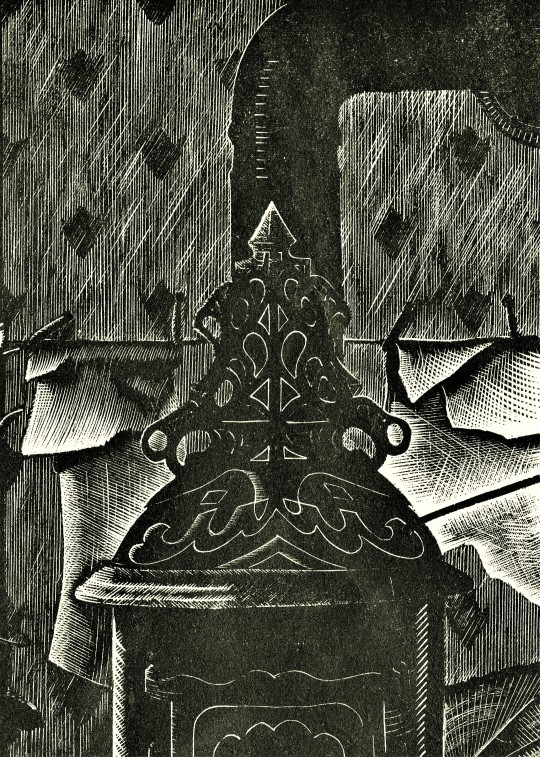
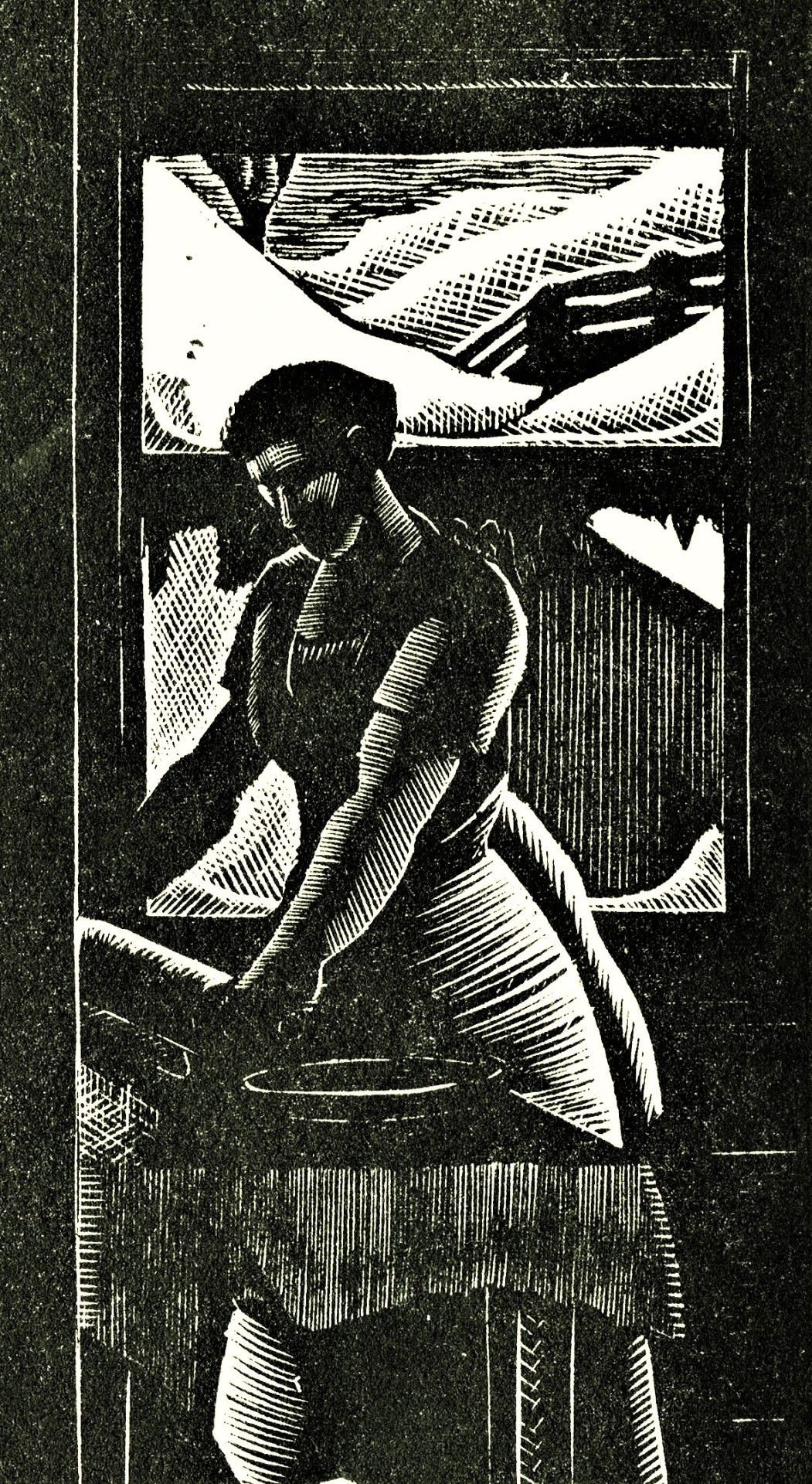




Wood Engraving Wednesday
FRANK UTPATEL
On this last Wednesday in May we present a wood engraving entitled Farmer's Holiday #4 by the noted Wisconsin artist Frank Utpatel (1905-1980). Utpatel made this engraving in the late 1930s as a Wisconsin artist in the Federal Art Project of the WPA. He is remembered mainly as an illustrator of fantasy, horror, and science fiction stories, especially through his longtime collaboration with August Derleth who founded the Arkham House publishing firm in Sauk City, Wisconsin, a major publisher in this genre, especially the works of H. P. Lovecraft. Although he is remembered for his work as an illustrator, he was also a highly accomplished wood engraver.
This print was scanned as part of our digital collection Wisconsin Arts Projects of the WPA from a portfolio of original prints in Special Collections that bears the title Making a Woodcut, although most to of the prints stored here are mainly lithographs, etchings, and linocuts.
The Wisconsin Arts Projects of the WPA digital collection was made possible with generous financial support from The Chipstone Foundation.
View more posts with Frank Utpatel's wood engravings.
View more posts from our Wisconsin Arts Projects digital collection.
View more posts with wood engravings!
#Wood Engraving Wednesday#wood engravings#wood engravers#Wisconsin artists#Frank Utpatel#Farmer's Holiday#Federal Art Project#Works Progress Administration#Making a Woodcut#Wisconsin Arts Projects of the WPA#digital collections
83 notes
·
View notes
Text
The vast majority of U.S. voters across the political spectrum don't support Republican proposals to gut Social Security benefits for Americans under age 50, according to polling results published Tuesday by the progressive think tank Data for Progress.
The survey, conducted Friday and Saturday, showed that 82% of all likely voters somewhat or strongly oppose policies that would mean "Americans currently under 50 would receive fewer Social Security benefits when they retire than those who receive Social Security benefits today."
Opposition was relatively consistent across parties: 84% of Democrats, 83% of Republicans, and 80% of Independents or third-party voters. The figures were also roughly the same regardless of age, gender, and education level.
Data for Progress further found that 72% of respondents—including 76% of Democrats, 66% of Republicans, and 72% of Independents or third-party voters—are "less likely to vote for a candidate who supported cutting future Social Security benefits for Americans currently under 50."

Back in January 2020, then-President Donald Trump—who is currently the front-runner for the GOP's 2024 nomination, despite his various legal issues and the argument that he is constitutionally disqualified from holding office again—said that programs like Social Security are "the easiest of all things" to cut.
Three of Trump's Republican 2024 opponents—Florida Gov. Ron DeSantis, ex-Vice President Mike Pence, and former South Carolina Gov. Nikki Haley—are now publicly pushing for changes to the program that would affect younger people.
Republicans in the U.S. House of Representatives have also set their sights on the program and are currently fighting for funding cuts to the Social Security Administration that Julie Tippens, legislative director of the American Federation of Government Employees, recently warned would "devastate the agency's ability to serve the American public."
Earlier this year, House Speaker Kevin McCarthy (R-Calif.) announced plans to establish a "commission" to examine ways to cut Social Security, and the 175-member Republican Study Committee proposed raising the program's full retirement age to 69.
As Data for Progress press secretary Abby Spring wrote in a Tuesday blog post:
"Republicans have argued that these proposed Social Security cuts are necessary to ensure that Social Security remains financially solvent—meaning the program would have enough funds to fully pay out beneficiaries—without affecting seniors currently receiving Social Security benefits.
However, other proposals, such as the Social Security Expansion Act or Social Security 2100, could extend the solvency of Social Security while increasing benefits for current and new recipients. These plans would be paid for by increasing taxes on wealthy Americans."
The think tank's poll also revealed widespread support for using tax hikes targeting the wealthy to sustain Social Security. Specifically, such policies were backed by 77% of everyone surveyed, including 83% of Democrats, 63% of Republicans, and 76% of Independents or third-party voters.
"When it comes to Social Security, candidates in the Republican Party are seemingly competing over who can offer the least popular proposals," said Data for Progress executive director Danielle Deiseroth. "No one—not even Republican voters—wants cuts to Social Security benefits for Americans under 50. Instead, voters would rather see taxes on wealthy Americans to ensure Social Security remains a guarantee for all."
Democratic President Joe Biden, who is seeking reelection, "proposed increasing taxes on the rich and businesses to prevent Medicare from running out of funds. But the latest White House budget does not propose a solution for extending Social Security," The Washington Post noted last month. "Numerous congressional Democrats have called for trillions in new taxes to avoid the Social Security shortfall, as well."
#us politics#news#common dreams#2023#social security checks#social security works#social security administration#social security#social security cuts#Data for Progress#polls#polling#alliance for retired Americans#donald trump#gov. ron desantis#Mike Pence#Nikki Haley#us house of representatives#American Federation of Government Employees#Julie Tippens#rep. kevin mccarthy#Republican Study Committee#Abby Spring#Danielle Deiseroth
11 notes
·
View notes
Text
Last July, The Intercept obtained an internal Bank of America memo that stated “we hope the ratio of job openings to unemployed is down to the more normal highs of the last business cycle.” Translated into English, this means the bank was rooting for there to be fewer job openings.
Likewise, a California real estate CEO said on an earnings call last year that a recession could be “good” if “it comes with a level of unemployment that puts employers back in the driver seat and allows them to get all their employees back into the office.”
Around the same time, an anonymous Texas businessman told the Dallas branch of the Federal Reserve about his delighted anticipation that “the workforce pulls its head out of its rear when a correction or recession makes jobs scarce and people start to feel the pain or fear of not providing for their family and loved ones.” He did have one concern, however — that the government might “jump back into the fight and pay them to do nothing again.”
Even Janet Yellen, the current secretary of the Treasury and former chair of the Fed during the Obama administration, wrote this in a 1996 memo: “Unemployment serves as a worker-discipline device because the prospect of a costly unemployment spell produces sufficient fear of job loss.”
6K notes
·
View notes
Text
Artifact Road Trip - Minnesota

The Bridge
By Cameron Booth, a tempera painting, was created for the Minnesota Art Project, Federal Art Project, Works Progress Administration.
Find out more about this #ArtifactRoadTrip painting on our Digital Artifact Collection: https://fdr.artifacts.archives.gov/objects/6797
Follow along each week as we feature a different artifact in our Museum Collection from each of the United States.
#minnesota#wpa#works progress administration#federal art project#new deal art#minnesota artists#museum from home#fdr#franklin d. roosevelt#artifact road trip
6 notes
·
View notes